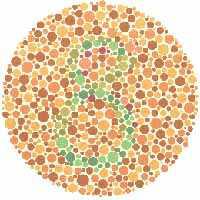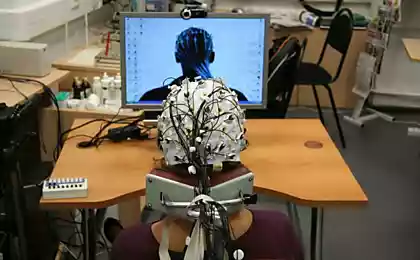589
The illusion that is the norm?
Mankind is accustomed to create illusions, indulging your senses.
The biggest of them - the blue sky.
8 fot text © «Antula»

02 Color Blindness - partial color blindness, one type of color vision disturbances.
Blindness was first described in 1794 by John. Dalton, who himself suffered from this deficiency. Color blindness occurs in 8% of men and 0, 5% of women. In the central part of the retina of human color-located nervous cells called "cones". They contain three types of color-sensitive pigment protein origin. One type of pigment is sensitive to red, another - to the green, and the third - to the blue. More precisely, they are sensitive to the wavelength corresponding to red, green and blue color in our understanding. The vision of the world of colors is provided by "folding" of these three colors in our brain. In humans, these pigments peak sensitivity at the wavelength 552-557 nm for red, 530 nm for green, and 426 nm - for blue. This is - normal, trichromatic color vision. At loss of one of these elements comes the partial color blindness - dihromaziya. Persons suffering dihromaziey, distinguish colors mainly for their brightness; qualitatively they are able to distinguish in the spectrum of a "warm" colors (red, orange, yellow) from the "cold" colors (green, blue, purple). Tsvetoslepye one color and people with reduced color vision perceive paint the world around them differently than we do, but often do not notice their differences from others. This happens because tsvetoslepye childhood learning called colored everyday objects conventional notation. They hear and remember that grass - green, sky - blue, blood - red. Furthermore, they retain the ability to distinguish between colors in the degree Grace.

03
Among dichromates distinguish blind to red (Protanopia), who perceived range is shortened to the end of the red and the green color blind (deuteranopia). When protanopia, red is perceived darker, mixed with dark green, dark brown and green - with a light gray, light yellow, light brown. When deuteranopia green mixed with light orange, light pink, and red - from light green, light brown. Blindness in the color purple - Tritanopia, is extremely rare and has no practical significance. When Tritanopia all colors of the spectrum are represented in shades of red or green. In some cases, there is a weakening of color perception - protanomaliya (weakening of the perception of red) and deuteranomalopia (weakening of the perception of the green).

04 All forms of congenital color blindness are hereditary. Women are agents of this pathological heredity; themselves retain normal vision and are tsvetoslepymi only when tsvetoslepogo have a father, along with at least heterozygous for this gene mother.
Acquired color vision disorder can occur in various diseases of the body and central nervous system; It affects one or both eyes and often - all primary colors. Disorders of color vision reveal using special tables or spectral instruments.

05 Treatment of color blindness.
Today, color blindness can not be treated.

06 Persons suffering from mild forms of color blindness learn to associate colors with certain objects and is usually able to identify colors in daily life, as well as people with normal color. But their sense of color is very different from the normal. In terms of web design, this means that a small group of visitors (3-4%) will necessarily be different from the rest of the visitors to the site color perception.
It is believed that the first accurate description of color blindness gave in 1794, the English chemist Dalton, to be exact - Dalton (John Dalton). Therefore, the data anomalies has been given the name of "color blindness».
Blindness has attracted attention in connection with the development of transport, widespread advertising of color and color signaling.

07 It is believed that the story related to the examination of color vision, started in 1875. When in Sweden near the small town Lagerlund was a train wreck, which entailed great sacrifices.
The crash was the consequence of the fact that the driver did not distinguish red. This misfortune, gave rise to the fact that when applying for a transport service became mandatory to assess color perception.

08 check yourself))))))) numbers in order: 25; 29; 45; 56; 6; 8

add))))))))))))) is closer to 20 000m at noon (noon at a height "not clear" does not happen) the sky takes on a completely different tsvet.i horizon is not a straight line.

Source:
The biggest of them - the blue sky.
8 fot text © «Antula»

02 Color Blindness - partial color blindness, one type of color vision disturbances.
Blindness was first described in 1794 by John. Dalton, who himself suffered from this deficiency. Color blindness occurs in 8% of men and 0, 5% of women. In the central part of the retina of human color-located nervous cells called "cones". They contain three types of color-sensitive pigment protein origin. One type of pigment is sensitive to red, another - to the green, and the third - to the blue. More precisely, they are sensitive to the wavelength corresponding to red, green and blue color in our understanding. The vision of the world of colors is provided by "folding" of these three colors in our brain. In humans, these pigments peak sensitivity at the wavelength 552-557 nm for red, 530 nm for green, and 426 nm - for blue. This is - normal, trichromatic color vision. At loss of one of these elements comes the partial color blindness - dihromaziya. Persons suffering dihromaziey, distinguish colors mainly for their brightness; qualitatively they are able to distinguish in the spectrum of a "warm" colors (red, orange, yellow) from the "cold" colors (green, blue, purple). Tsvetoslepye one color and people with reduced color vision perceive paint the world around them differently than we do, but often do not notice their differences from others. This happens because tsvetoslepye childhood learning called colored everyday objects conventional notation. They hear and remember that grass - green, sky - blue, blood - red. Furthermore, they retain the ability to distinguish between colors in the degree Grace.

03
Among dichromates distinguish blind to red (Protanopia), who perceived range is shortened to the end of the red and the green color blind (deuteranopia). When protanopia, red is perceived darker, mixed with dark green, dark brown and green - with a light gray, light yellow, light brown. When deuteranopia green mixed with light orange, light pink, and red - from light green, light brown. Blindness in the color purple - Tritanopia, is extremely rare and has no practical significance. When Tritanopia all colors of the spectrum are represented in shades of red or green. In some cases, there is a weakening of color perception - protanomaliya (weakening of the perception of red) and deuteranomalopia (weakening of the perception of the green).

04 All forms of congenital color blindness are hereditary. Women are agents of this pathological heredity; themselves retain normal vision and are tsvetoslepymi only when tsvetoslepogo have a father, along with at least heterozygous for this gene mother.
Acquired color vision disorder can occur in various diseases of the body and central nervous system; It affects one or both eyes and often - all primary colors. Disorders of color vision reveal using special tables or spectral instruments.

05 Treatment of color blindness.
Today, color blindness can not be treated.

06 Persons suffering from mild forms of color blindness learn to associate colors with certain objects and is usually able to identify colors in daily life, as well as people with normal color. But their sense of color is very different from the normal. In terms of web design, this means that a small group of visitors (3-4%) will necessarily be different from the rest of the visitors to the site color perception.
It is believed that the first accurate description of color blindness gave in 1794, the English chemist Dalton, to be exact - Dalton (John Dalton). Therefore, the data anomalies has been given the name of "color blindness».
Blindness has attracted attention in connection with the development of transport, widespread advertising of color and color signaling.

07 It is believed that the story related to the examination of color vision, started in 1875. When in Sweden near the small town Lagerlund was a train wreck, which entailed great sacrifices.
The crash was the consequence of the fact that the driver did not distinguish red. This misfortune, gave rise to the fact that when applying for a transport service became mandatory to assess color perception.

08 check yourself))))))) numbers in order: 25; 29; 45; 56; 6; 8

add))))))))))))) is closer to 20 000m at noon (noon at a height "not clear" does not happen) the sky takes on a completely different tsvet.i horizon is not a straight line.

Source:
























